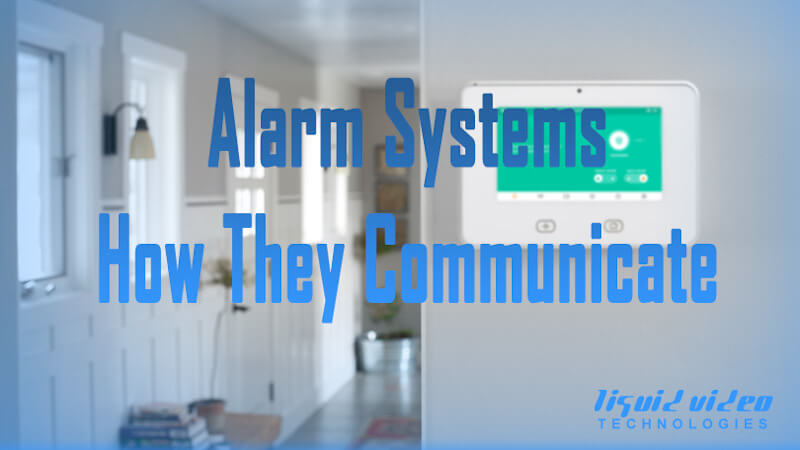There are many options for how your alarm systems will communicate with the monitoring station. Unfortunately, many homeowners and business owners put very little thought into the different alarm system communication technologies that are available and how these technologies can impact the protection they get from an alarm system. This can lead to alarm system installation errors, false alarms, and increased vandalism.
Here are some of the different technologies available for communicating with the monitoring station and how they impact your alarm systems:
- GPRS – General Packet Radio Service is a new technology that uses cellular phone networks to deliver digital information very fast, especially across short distances. The technology utilizes cellular phone technology as its backbone network. GPRS systems use radio frequencies to send and receive data messages. For example, a burglar that comes into your home may be given an opportunity to signal his location by sending a text message via GPRS technology back to the monitoring station where he will be instructed what steps need to be taken next by law enforcement personnel.
- SMS – commonly known as text messaging, which is limited to 160 characters in length (or “characters”) but can be used in lieu of an outbound voice message. For example, if you have an emergency situation and want to alert the monitoring station that a crime has occurred, it is often easier to simply send a text message than to call 911.
- Short Message Service – This technology is similar to SMS but allows for more details about the emergency situation to be included in the message sent back to the monitoring station by alerting them of the incident. For example, if your alarm system has been triggered and you want law enforcement personnel or fire/rescue personnel dispatched to your home immediately, you can use an outbound short message service alarm communication technology (SMS) to send a brief text message that notifies those responsible for dispatching help quickly.
- IP/Backup Cellular – This is an alarm communication technology that is commonly used in conjunction with a GSM-GPRS or CDMA security system. It is the same as the GSM-GPRS alarm system (except it will still perform if there is a power failure), but it also has backup cellular call messaging ability built into the alarm system. If there is ever a power outage and cellular service has been temporarily lost, the cellular messaging portion of your security system can automatically switch over to an alternate power source, such as a battery backup in order to continue sending outbound messages to the monitoring station until communications are restored. This is an important feature to have in metropolitan areas that primarily use landline phone service, where power outages are more likely to happen.
- Wired Alarm Monitoring – Is one of the most common alarm communication technologies used by businesses and homeowners. It could be that your alarm system is connected directly to the monitoring station via telephone wires, or it could be that it’s connected through a Fire/Security Console (also referred to as a Central Station), which then automatically receives all alarm communications from all of its associated alarm systems.
- Power Line Carrier – Uses the existing electrical wiring within your home or business to communicate with the monitoring station. This type of alarm system can be cheaper than hard-wiring it, but it should be used only as a last resort, and then only if your area has no interference from things such as power transformers or other appliances that cause noise on the electrical lines.
- Radio Frequency – To date, this is one of the most reliable alarm system communication technologies available. It is responsible for sending and receiving all of the communications between your security system and the Central Station. There are three different types: Radio Transmission (RF), Radio Frequency Data System (RFDS) & Digital Voice Services (DVS).
- Cellular – Another form of communication technology that is available for your alarm system. The RF communication system will send and receive text messages between the alarm and monitoring station over the cellular phone network.
- Voice Communication – This is also part of the newer, more reliable radio frequency systems, although it is less common than radio transmission or data circuits. This is a type of communication that transmits voice messages from your alarm system to a monitoring station, and then back to you (or a neighbor). This can be useful if you have an elderly or handicapped resident in your home who is not able to use other contemporary alarm communications technologies.
- Wireless Alarm Systems – This type of alarm system will have a wire that connects the alarm to a power source and a separate transmitter that sends and receives all communication with either the Central Station or the monitoring party. All wireless alarm systems have certain advantages over hard-wired systems, such as being able to pick up your handheld cell phone and place an outbound call even if you’re in the middle of cooking dinner, rather than having to stop what you’re doing to answer a landline phone. Another advantage is that it doesn’t require any special-purpose wiring (although it does require power).
Interested in learning about alarm systems that we offer for businesses? Fire Alarm Systems | Liquid Video Technologies in South Carolina takes you to the fire alarm systems offered by Liquid Video Technology.
![]()
If you would like liquidvideotechnologies.com to discuss developing your Home Security System, Networking, Access Control, Fire, IT consultant, or PCI Compliance, please do not hesitate to call us at 864-859-9848 or you can email us at deveren@liquidvideotechnologies.com.


Recent Comments